Potřebujeme váš souhlas k využití jednotlivých dat, aby se vám mimo jiné mohly ukazovat informace týkající se vašich zájmů. Souhlas udělíte kliknutím na tlačítko „OK“.
ASTM D5904-02(2009)
Standard Test Method for Total Carbon, Inorganic Carbon, and Organic Carbon in Water by Ultraviolet, Persulfate Oxidation, and Membrane Conductivity Detection
Automaticky přeložený název:
Standardní zkušební metoda pro celkový uhlík, anorganického uhlíku a organického uhlíku ve vodě působením ultrafialového, persulfát oxidace, a membránových vodivosti detekce
NORMA vydána dne 1.10.2009
Informace o normě:
Označení normy: ASTM D5904-02(2009)
Poznámka: NEPLATNÁ
Datum vydání normy: 1.10.2009
Kód zboží: NS-33030
Počet stran: 7
Přibližná hmotnost: 21 g (0.05 liber)
Země: Americká technická norma
Kategorie: Technické normy ASTM
Kategorie - podobné normy:
Anotace textu normy ASTM D5904-02(2009) :
Keywords:
carbon, carbon-dioxide, inorganic-carbon, low-temperature-oxidation, membrane-conductivity-detection, organic carbon, total carbon, Carbon content--water, Carbon dioxide content, Inorganic carbon (IC), Low-temperature testing--water, Membrane conductivity detection, Organic carbon (OC), Total organic carbon (TOC), ICS Number Code 13.060.50 (Examination of water for chemical substances)
Doplňující informace
| Significance and Use | ||||||||||||||
|
This test method is used for determination of the carbon content of water from a variety of natural, domestic, and industrial sources. In its most common form, this test method is used to measure organic carbon as a means of monitoring organic pollutants in high purity and drinking water. These measurements are also used in monitoring waste treatment processes. The relationship of TOC to other water quality parameters such as chemical oxygen demand (COD) and total oxygen demand (TOD) is described in the literature. |
||||||||||||||
| 1. Scope | ||||||||||||||
|
1.1 This test method covers the determination of total carbon (TC), inorganic carbon (IC), and total organic carbon (TOC) in water in the range from 0.5 to 30 mg/L of carbon. Higher levels may be determined by sample dilution. The test method utilizes ultraviolet-persulfate oxidation of organic carbon, coupled with a CO2 selective membrane to recover the CO2 into deionized water. The change in conductivity of the deionized water is measured and related to carbon concentration in the oxidized sample. Inorganic carbon is determined in a similar manner without the requirement for oxidation. In both cases, the sample is acidified to facilitate CO2 recovery through the membrane. The relationship between the conductivity measurement and carbon concentration is described by a set of chemometric equations for the chemical equilibrium of CO2, HCO3−, H+, and the relationship between the ionic concentrations and the conductivity. The chemometric model includes the temperature dependence of the equilibrium constants and the specific conductances. 1.2 This test method has the advantage of a very high sensitivity detector that allows very low detection levels on relatively small volumes of sample. Also, use of two measurement channels allows determination of CO2 in the sample independently of organic carbon. Isolation of the conductivity detector from the sample by the CO2 selective membrane results in a very stable calibration, with minimal interferences. 1.3 This test method was used successfully with reagent water spiked with sodium bicarbonate and various organic materials. It is the user's responsibility to ensure the validity of this test method for waters of untested matrices. 1.4 This test method is applicable only to carbonaceous matter in the sample that can be introduced into the reaction zone. The injector opening size generally limits the maximum size of particles that can be introduced. 1.5 In addition to laboratory analyses, this test method may be applied to on line monitoring. 1.6 The values stated in SI units are to be regarded as standard. No other units of measurement are included in this standard. 1.7 This standard does not purport to address all of the safety concerns, if any, associated with its use. It is the responsibility of the user of this standard to establish appropriate safety and health practices and determine the applicability of regulatory limitations prior to use. |
||||||||||||||
| 2. Referenced Documents | ||||||||||||||
|
Podobné normy:
Historická
1.9.2012
Historická
1.9.2012
Historická
15.6.2012
Historická
1.10.2008
Historická
1.10.2009
Historická
1.1.2013
Doporučujeme:
Aktualizace technických norem
Chcete mít jistotu, že používáte pouze platné technické normy?
Nabízíme Vám řešení, které Vám zajistí měsíční přehled o aktuálnosti norem, které používáte.
Chcete vědět více informací? Podívejte se na tuto stránku.


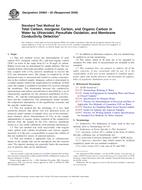
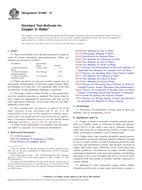 ASTM D1688-12
ASTM D1688-12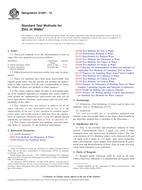 ASTM D1691-12
ASTM D1691-12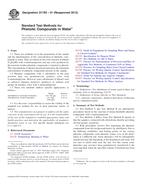 ASTM D1783-01(2012)..
ASTM D1783-01(2012)..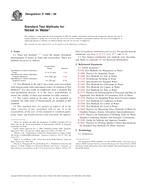 ASTM D1886-08
ASTM D1886-08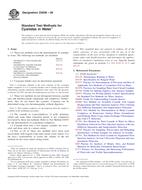 ASTM D2036-09
ASTM D2036-09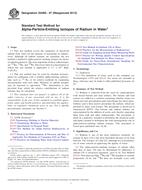 ASTM D2460-07(2013)..
ASTM D2460-07(2013)..
 Cookies
Cookies
